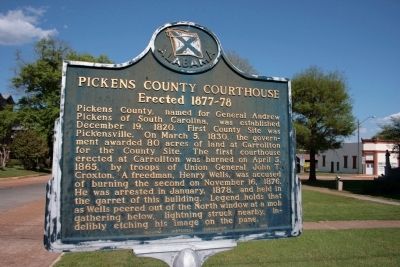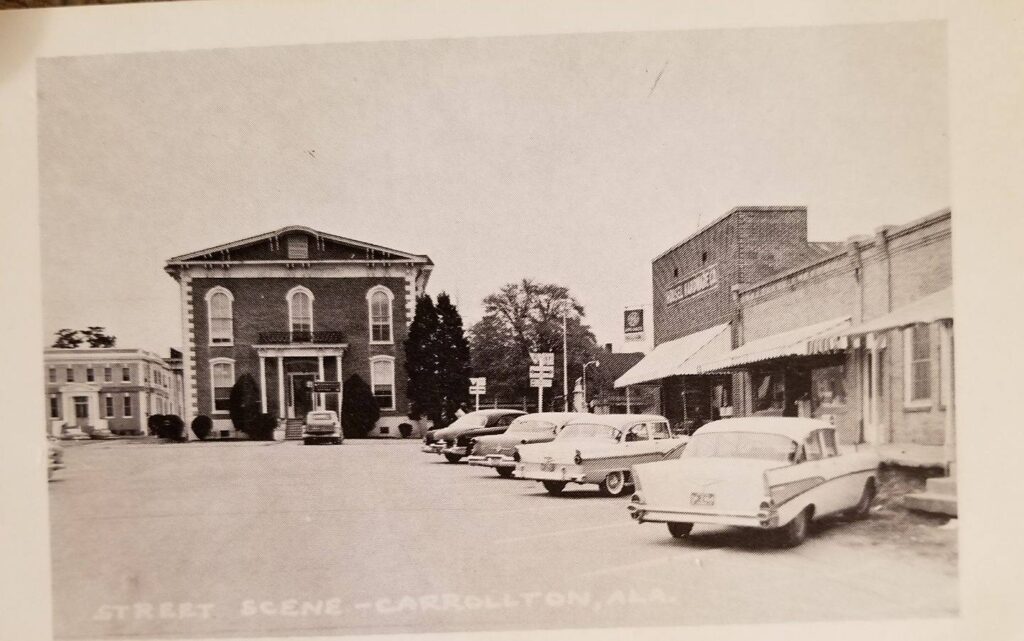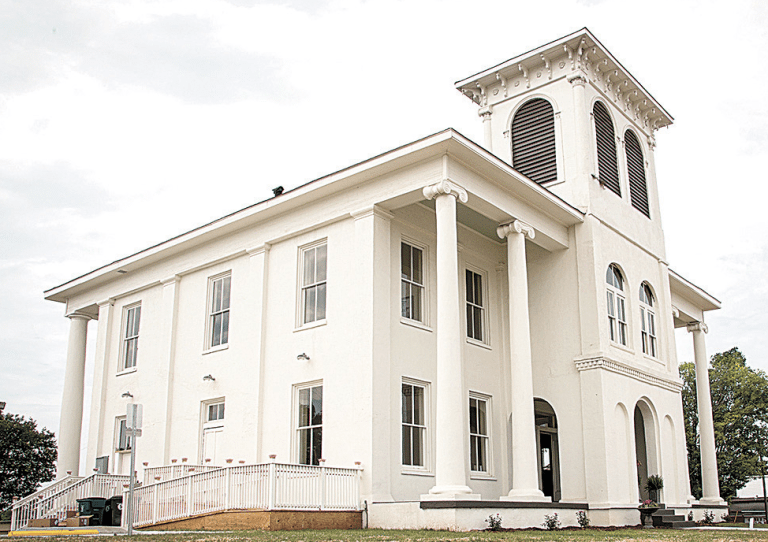Etched in the windows of Pickens County Courthouse in Carrollton, the haunted face has captivated locals and ghost hunters for decades.
The face is said to be the remnants of emancipated slave Henry Wells who according to legend, was arrested in January 1878 for the robbing of a store. He was subsequently accussed and charged with the burning of the former Pickens County Courthouse which happened on November 16, 1876; this is the county’s second courthouse as the first one was destroyed during the American Civil War (1861 – 1865). The arrest of Wells comes after the Reconstruction era (1865-1877), a period where the Reconstruction Amendments (Thirteenth, Fourteenth, and Fifteenth amendments) guaranteed freedom and civil rights to the freed slaves.

According to the West Alabamian newspaper date on December 13, 1876, stolen goods from the store was found in the homes of Wells and his accomplice Bill Buckhalter. While the goods did not suggest their part in the burning of the courthouse, the duo were held liable for it. Buckhalter who was first arrested, was tortured into confessing for both crimes and incriminating Wells. He reportedly died five days after his arrest.
Days after Buckhalter’s death, Wells was caught hiding in a shed at the edges of the town. He was promptly arrested and brought to the sheriff’s office. However, fearing that a mob might break into the office, the sheriff ordered for Wells to be sent to Tuscaloosa.
On the journey to Tuscaloosa, Wells had attempted to escape but was shot in the leg. He was brought back to Carrolton for treatment. However, it didn’t take long before the community was aware of his capture. Armed with torches and sticks, an angry mob gathered outside the courthouse in the midst of a thunderstorm, determined to exact revenge.
For protection, the sheriff brought Wells to the courthouse’s garret to keep him away from the mob. However, angered by the mob, Wells peered out of the window and hollered at the crowd. As the legend says, a bolt of lighting struck the courthouse and etched his wrathful face permanently on the window.
“I am innocent. If you kill me, I am going to haunt you for the rest of your lives!”
– Henry Wells yelling at the crowd before he was taken outside of the courthouse and lynched.
Against the sheriff’s order, the group charged into the courthouse and dragged Wells to the open field. There, he was tortured and coerced into admitting his criminal involvement with Buckhalter. Wells purportedly confessed to burning down the courthouse before being lynched for the crimes. The very next day, the haunted face was spotted by a passing by townsfolk. Over a century later, the now famous haunted face continues to be visible.
Another popular story regarding the origins of the haunted face suggest that it may have been Nathaniel Pierce, a murder suspect who was arrested in September, 1877. Shortly after Pierce arrest, a mob of angry residents stormed into the local jail to avenge for the death of their people. Pierce was abducted to the outskirts of the town where he was ‘sentenced’ to death by and lynched.
In spite of the widespread tales of both stories, it is impossible for the haunted face in the courthouse window to be Bill, Wells or Pierce. This is because the windows were installed in February, 1878, weeks and months after their death. As reported by West Alabamian, the windows were installed in the courthouse in preparation for a court session that was scheduled to be held in March, 1878.

The legend behind the face in the courthouse window was eventually made famous in the 1969 book 13 Alabama Ghosts and Jeffrey written by folklorist Kathryn Tucker Windham. In 1974, the Alabama Historical Association erected a historical marker telling the brief history of Pickens County Courthouse and the legend behind the haunted face.
The story of Henry Wells and the haunted face was also immortalized in The Face In The Courthouse Window theatrical play which is produced each spring to raise funds for the preservation of the historic courthouse.

The Indestructible Face
Over the 20th century, several attempts were made to wash off the stained glass window, both from the inside and the outside. However, the haunted face was completely resistant to water, soap, alcohol, and even cleaning chemicals. It was also reported that a severe hailstorm once ravaged the town, destroying every window pane in the historic courthouse except the one with Wells’ face. The seemingly indestructible window have convinced residents of Carrollton that something supernatural is at play.
Interestingly, the haunted face is completely invisible from the inside of the window. It is also visible from the outside only at certain angles to the window. To help visitors get a closer look of the face, a permanent binocular was installed across the street.
History of Carrollton and Pickens County Courthouse
The history of Carrollton dates back to 1830 when the commissioner of Pickens County was awarded 80 acres of land to establish a county seat and set up a town. The town was named after Charles Carroll of Carrollton, an Irish-American politician, and signatory of the Declaration of Independence.
Some of the Carrolton first settler include an Hoose, Stansel, Stone, Clitherall, Lanier, Davis, Martin, Hill, and Johnston families. Somewhere during the mid 1850s, Carrolton set up its first courthouse. However, it was destroyed by troops of Union General John T. Croxton on April 5, 1865. A second courthouse was promptly built after the end of the Civil War, only to face the same fate when it was purportedly razed to the ground by Henry Wells.

Unfazed, the community of Carrolton pooled together donations and rebuild the town’s third courthouse in under a year. The courthouse, which is now etched with the haunted face of Wells, has stood still ever since and is now the main attraction of the town.
How To Visit Pickens County Courthouse
The address of Pickens County Courthouse is Columbus St, Carrollton, AL 35447, United States. Note that the historical Pickens County Courthouse where the haunted face can be found is located in Alabama, not Georgia as many had believed.
Visit to the Pickens County Courthouse is not allowed as the property is currently under preservation.




